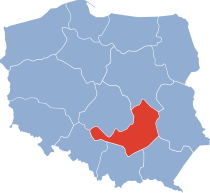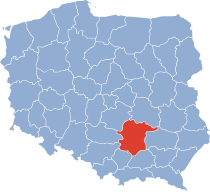
Lesser Poland, often known by its Polish name Małopolska, is a historical region situated in southern and south-eastern Poland. Its capital and largest city is Kraków. Throughout centuries, Lesser Poland developed a separate culture featuring diverse architecture, folk costumes, dances, cuisine, traditions and a rare Lesser Polish dialect. The region is rich in historical landmarks, monuments, castles, natural scenery and UNESCO World Heritage Sites.

Silesian Voivodeship is a voivodeship, or province, in southern Poland centered on the historic region known as Upper Silesia, with Katowice serving as its capital.

Katowice Voivodeship can refer to one of two political entities in Poland:
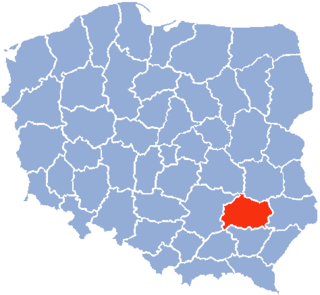
The Tarnobrzeg Voivodeship was a unit of administrative division and local government in Poland in years 1975-1998, superseded in parts by Subcarpathian Voivodeship, Świętokrzyskie Voivodeship and Lublin Voivodeship. Its capital city was Tarnobrzeg, although the major city in the region was Stalowa Wola.
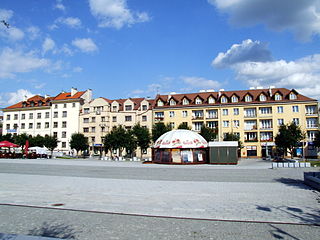
Ostrowiec Świętokrzyski, often referred to as Ostrowiec, is a city in southeastern Poland, in the historical region of Lesser Poland, with 66,258 residents. The town is one of the historic centers of Polish industry and metallurgy, and was part of the Old-Polish Industrial Region, the oldest industrial basin of the country.

Sandomierz Voivodeship was a unit of administration and local government in Poland from the 14th century to the partitions of Poland in 1772–1795. It was part of the Lesser Poland region and the Lesser Poland Province. Originally Sandomierz Voivodeship also covered the area around Lublin, but in 1474 its three eastern counties were organized into Lublin Voivodeship. In the 16th century, it had 374 parishes, 100 towns and 2586 villages. The voivodeship was based on the Sandomierz ziemia, which earlier was the Duchy of Sandomierz. The Duchy of Sandomierz was created in 1138 by King Bolesław III Wrymouth, who in his testament divided Poland into five principalities. One of them, with the capital at Sandomierz, was assigned to Krzywousty's son, Henry of Sandomierz. Later on, with southern part of the Seniorate Province, the Duchy of Sandomierz created Lesser Poland, divided into Kraków and Sandomierz Voivodeships.

Włoszczowa County is a unit of territorial administration and local government (powiat) in Świętokrzyskie Voivodeship, south-central Poland. It came into being on January 1, 1999, as a result of the Polish local government reforms passed in 1998. Its administrative seat and only town is Włoszczowa, which lies 46 kilometres (29 mi) west of the regional capital Kielce.
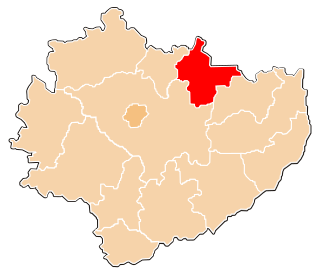
Starachowice County is a unit of territorial administration and local government (powiat) in Świętokrzyskie Voivodeship, south-central Poland. It came into being on January 1, 1999, as a result of the Polish local government reforms passed in 1998. Its administrative seat and largest town is Starachowice, which lies 37 kilometres (23 mi) north-east of the regional capital Kielce. The only other town in the county is Wąchock, lying 5 km (3 mi) north-west of Starachowice.
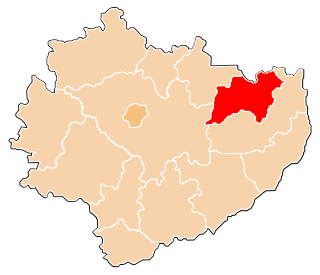
Ostrowiec County is a unit of territorial administration and local government (powiat) in Świętokrzyskie Voivodeship, south-central Poland. It came into being on January 1, 1999, as a result of the Polish local government reforms passed in 1998. Its administrative seat and largest town is Ostrowiec Świętokrzyski, which lies 56 kilometres (35 mi) east of the regional capital Kielce. The county also contains the towns of Ćmielów, lying 10 km (6 mi) south-east of Ostrowiec Świętokrzyski, and Kunów, 9 km (6 mi) west of Ostrowiec Świętokrzyski.

Będzin County is a unit of territorial administration and local government (powiat) in Silesian Voivodeship, southern Poland. It came into being on 1 January 1999 as a result of the Polish local government reforms passed in 1998. Its administrative seat and largest town is Będzin, which lies 13 kilometres (8 mi) north-east of the regional capital Katowice. The county contains four other towns: Czeladź, 3 km (2 mi) west of Będzin, Wojkowice, 7 km (4 mi) north-west of Będzin, Sławków, 20 km (12 mi) east of Będzin, and Siewierz, 18 km (11 mi) north-east of Będzin.

Zawiercie County is a unit of territorial administration and local government (powiat) in Silesian Voivodeship, southern Poland. It came into being on January 1, 1999, as a result of the Polish local government reforms passed in 1998. Its administrative seat and largest town is Zawiercie, which lies 41 kilometres (25 mi) north-east of the regional capital Katowice. The county contains five other towns: Poręba, 6 km (4 mi) west of Zawiercie, Łazy, 8 km (5 mi) south of Zawiercie, Ogrodzieniec, 9 km (6 mi) south-east of Zawiercie, Szczekociny, 33 km (21 mi) north-east of Zawiercie, and Pilica, 18 km (11 mi) east of Zawiercie.

Myszków County is a unit of territorial administration and local government (powiat) in Silesian Voivodeship, southern Poland. It came into being on January 1, 1999, as a result of the Polish local government reforms passed in 1998. Its administrative seat and largest town is Myszków, which lies 44 kilometres (27 mi) north-east of the regional capital Katowice. The county also contains the towns of Żarki, lying 7 km (4 mi) north-east of Myszków, and Koziegłowy, 11 km (7 mi) west of Myszków.

Kielce Voivodeship - a unit of administrative division and local government in Poland in years 1921–1939. At that time, it covered northern counties of the historic province of Lesser Poland, including such cities as Radom, Częstochowa and Sosnowiec. On 1 April 1938, its borders changed, see: Territorial changes of Polish Voivodeships on 1 April 1938. Capital city: Kielce.

Kraków Voivodeship was a unit of administrative division and local government in Poland in years 1919–1939. It occupied a large area of the southern part of the country, including such cities as Kraków, Jaworzno and Tarnów. Its capital city was Kraków.

Łódź Voivodeship was a unit of administrative division and local government in Poland from 1919 to 1939. At the time, it covered a large portion of the mid-western part of the country, including such cities as Łódź, Piotrków Trybunalski, Sieradz and Radomsko. The capital of the Łódź Voivodeship was always Łódź, but the land that comprised it changed several times.
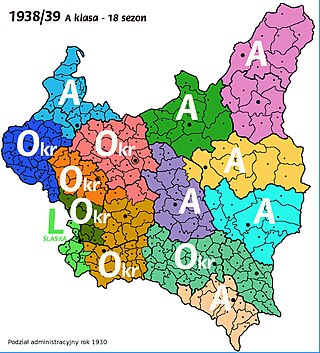
In the Second Polish Republic, there was not a national, Second Division, as we know it today, although the creation of the second division was proposed on several occasions. On Sunday, 26 September 1937 in Częstochowa, a conference of regional teams from across the nation took place, to discuss the creation of the league. Officials of several clubs arrived, such as Brygada Częstochowa, Gryf Toruń, Śmigły Wilno, Rewera Stanisławów, Dąb Katowice, Unia Sosnowiec, Strzelec Janowa Dolina, and WKS Grodno. Also, invited were officials of HCP Poznań, Podgorze Kraków, Naprzód Lipiny and Union Touring Łódź, but for unknown reasons they did not show up. The officials talked about creation of a National B-League, but nothing came out of this project. Instead, in the years 1921-1939, several Voivodeships held their own games and those leagues were known as A-Classes. In 1927, the elite Polish Football League was created, which by the late 1930s consisted of 10 teams. The teams that did not make it to the Ekstraklasa, played in the A-Classes.
Old Poland Voivodeship was a proposed Voivodeship of Poland, which, however, has not been created. It was to cover the area of northern part of the historical province of Lesser Poland, with such cities as Częstochowa, Kielce and Sandomierz.

A Dowództwo Okręgu Korpusu was a military district of the Ministry of Military Affairs of the Second Polish Republic. It served as an organizational, mobilisational, and administrative body of the Polish Army, and all of Poland's local military units were subject to the Corps Commands.

The Silesian Voivodeship, also known as the Basin–Silesian Voivodeship, and the Silesian–Dąbrowa Voivodeship, was a voivodeship (province) of Poland, with capital in Katowice, that existed from 1945 to 1950. It was located in the Upper Silesia. The voivodeship was established in 1945 and until 28 June 1945, remained under the administration of the Provisional Government of the Republic of Poland, which then was replaced by the Provisional Government of National Unity. On, 19 February 1947, the provisional government was replaced by the Polish People's Republic. On 28 June 1946, the District of Opolian Silesia had been incorporated into the voivodeship. It existed until 6 July 1950, when it was partitioned into the voivodeships of Katowice and Opole.

